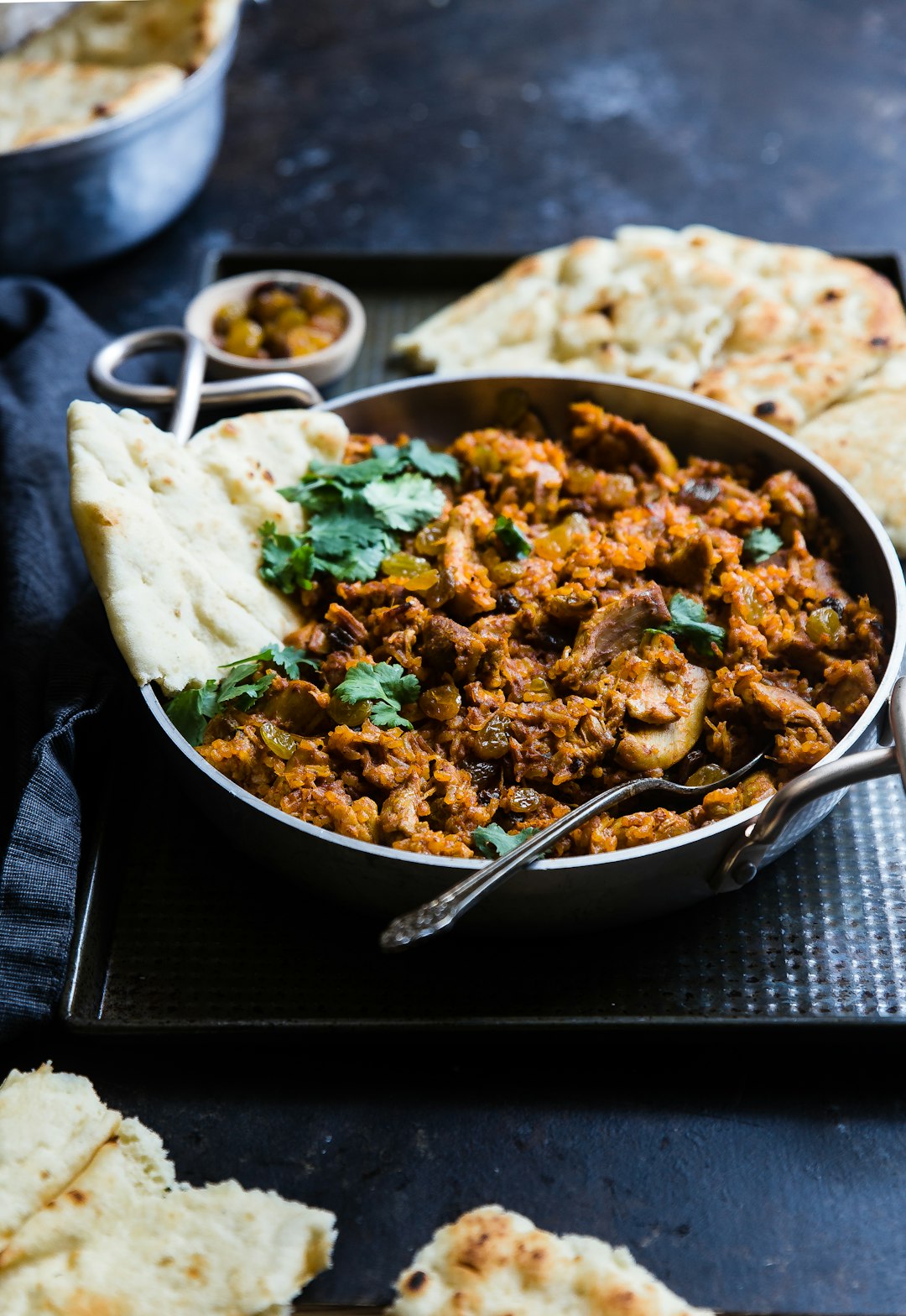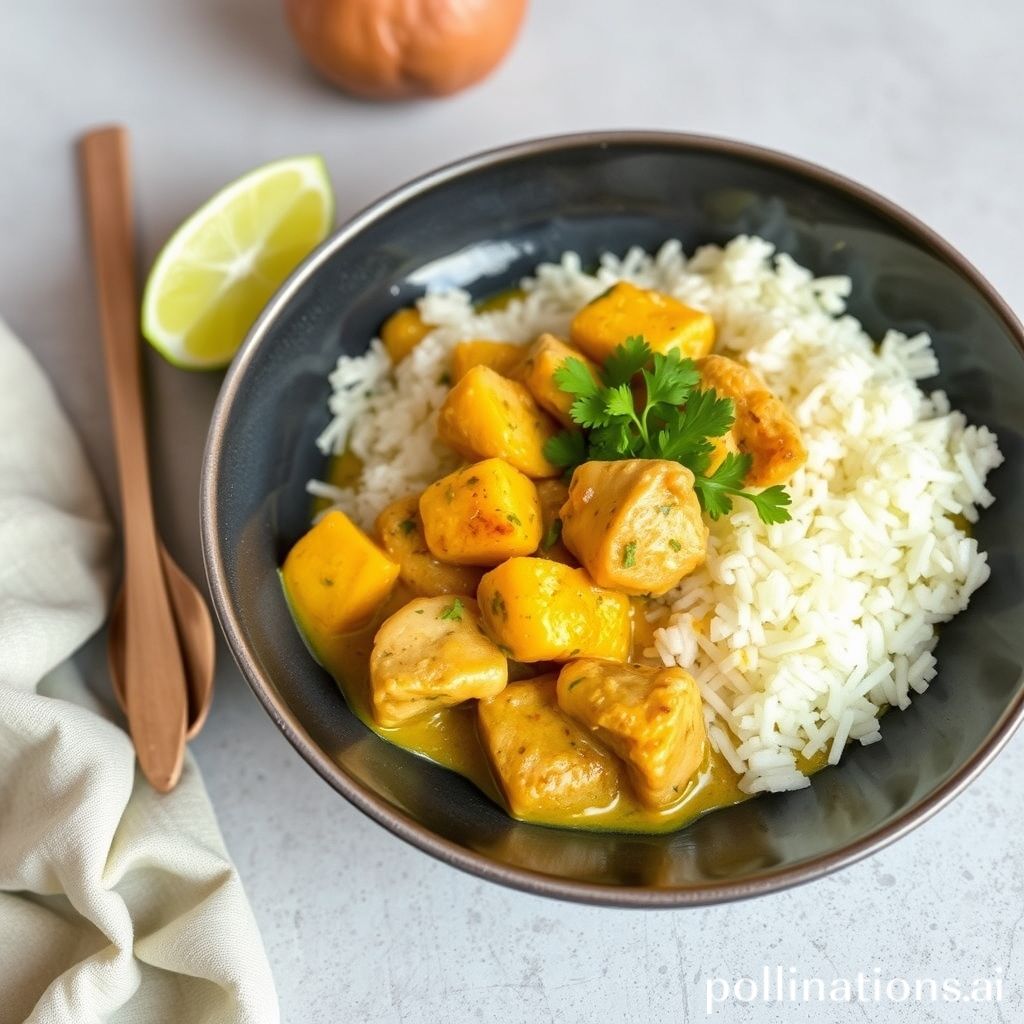Table of Contents
- Introduction
- Key ingredients for Coconut Curry Chicken
- Step-by-step guide to preparing Coconut Curry Chicken
- Variations and tips for Coconut Curry Chicken
- Pairing Coconut Curry Chicken with side dishes
- Nutritional benefits of Coconut Curry Chicken
- Common mistakes to avoid when making Coconut Curry Chicken
- Popular accompaniments and garnishes for Coconut Curry Chicken
- Storing and reheating Coconut Curry Chicken leftovers
- Conclusion
- Frequently Asked Questions
Introduction
Embark on a culinary journey that encapsulates the essence of tradition and innovation with our Coconut Curry Chicken recipe. This dish marries the lush, creamy texture of coconut milk with the aromatic spices that define curry’s unique character. Whether you’re a seasoned chef or a home-cooking enthusiast, our step-by-step guide will help you master this flavorful concoction in no time.
Imagine a simmering pot filled with succulent pieces of chicken, gently bubbling away in a rich, savory sauce scented with garlic, ginger, and lemongrass. A sprinkle of chili gives it that perfect kick, ensuring that your Coconut Curry Chicken is nothing short of a flavor explosion.
To get started, gather your ingredients: 1 pound of chicken, 1 can of coconut milk, 2 tablespoons of curry powder, 1 tablespoon of minced garlic, 1 tablespoon of minced ginger, 1 tablespoon of vegetable oil, 1 tablespoon of sugar, salt to taste, and a handful of fresh cilantro for garnish.
Prepare your senses for a delightful encounter, where each bite takes you on a journey through layers of spice, sweetness, and the creamy depth of coconut. Our recipe not only promises a meal that’s bursting with flavor but also an experience that celebrates the art of cooking itself.
Key ingredients for Coconut Curry Chicken
Coconut Curry Chicken is a delightful dish that brings together an array of flavors to create a rich and satisfying culinary experience. The key to this dish lies in its carefully selected ingredients that blend to create a harmonious taste. At the heart of Coconut Curry Chicken is the chicken itself, typically boneless and skinless, which absorbs the flavors of the other ingredients beautifully. High-quality coconut milk is essential, providing a creamy base that infuses the dish with a subtle sweetness and rich texture.
The curry component is crafted using a blend of spices such as curry powder, turmeric, and coriander. These spices add depth and warmth to the dish, complemented by fresh garlic and ginger for a punch of aromatic flavor. Onions and bell peppers often feature prominently, adding both sweetness and crunch. Don’t forget fresh cilantro which imparts a vibrant freshness to the dish. All of these ingredients come together to create a fragrant and deeply satisfying Coconut Curry Chicken that is both comforting and exotic.
Step-by-step guide to preparing Coconut Curry Chicken
Preparing Coconut Curry Chicken is a delightful experience that results in a dish full of flavors. Start by gathering the ingredients: chicken pieces, coconut milk, curry powder, onion, garlic, ginger, tomatoes, bell peppers, and cilantro. Begin by marinating the chicken pieces in curry powder with a bit of salt and pepper for about 15 minutes to enhance the flavor.
Next, heat oil in a large pan over medium heat, adding chopped onions, minced garlic, and grated ginger. Sauté until the onions become translucent. Then, add the marinated chicken pieces and cook until they are browned on all sides. This should take about 5-7 minutes.
Add diced tomatoes and sliced bell peppers to the pan, stirring well to combine with the chicken. Pour in the coconut milk, stirring gently to create a rich and creamy sauce. Allow the mixture to simmer over low heat for 20 minutes, letting the flavors meld and the chicken become tender.
Finally, garnish with fresh cilantro before serving hot with rice or naan. Enjoy a comforting and aromatic Coconut Curry Chicken that is sure to tantalize the taste buds.
Variations and tips for Coconut Curry Chicken
Coconut Curry Chicken is a versatile dish that lends itself well to various adaptations depending on personal taste and dietary requirements. One popular variation is to add vegetables such as bell peppers, peas, or sweet potatoes, which not only enhance the flavor but also add a nutritional boost. For those preferring a plant-based meal, tofu or chickpeas can serve as a satisfying substitute for chicken. Adjusting the heat level is easily achieved by tweaking the amount of chili peppers or using milder alternatives.
Adding different herbs and spices can also elevate the dish. Fresh cilantro or basil offer a fresh taste, while spices like turmeric or cumin can deepen the flavor profile. When it comes to the curry base, you might experiment with different types of curry pastes, such as red or green curry, each bringing its unique flair.
A few tips for achieving the best Coconut Curry Chicken include ensuring that the chicken is browned well for extra flavor and using full-fat coconut milk for a richer sauce. Also, allowing the dish to simmer helps the spices meld together beautifully. Serving the curry with jasmine rice or naan bread complements the robust flavors perfectly. Whether traditional or with a twist, this dish offers delightful possibilities.
Pairing Coconut Curry Chicken with side dishes
Pairing Coconut Curry Chicken with the right side dishes can elevate the meal to new heights, offering a delightful balance of flavors and textures. A classic choice is fluffy basmati rice, which absorbs the creamy curry sauce beautifully and adds a fragrant touch. Alternatively, jasmine rice offers a slightly sweeter aroma that complements the coconut curry’s spice. For a healthier option, consider serving quinoa, which provides a nutty flavor and an extra punch of protein.
In addition to grains, a fresh salad can provide a crisp counterbalance to the rich curry. A cucumber and mint salad, for instance, offers a cooling effect that contrasts pleasantly with the warmth of the curry. Steamed or roasted vegetables like broccoli, carrots, and bell peppers can also add nutritional value and vibrant color to your plate.
For a more indulgent side, naan bread or roti can be served, allowing diners to scoop up the curry for a more interactive dining experience. These bread options add a chewy texture and satisfyingly complement the dish’s rich, savory notes. When choosing side dishes, consider not only how they taste on their own but how they will interact with the flavors of Coconut Curry Chicken for a well-rounded meal.
Nutritional benefits of Coconut Curry Chicken
Coconut Curry Chicken is a delicious and nutritious dish that brings together a variety of health benefits. The primary ingredient, chicken, is an excellent source of lean protein, which is crucial for muscle growth and repair. It also provides essential vitamins and minerals such as vitamin B6, niacin, and selenium, contributing to overall health and well-being.
The coconut milk in the curry is rich in healthy fats, particularly medium-chain triglycerides (MCTs), which have been shown to boost metabolism and support weight loss. It also contains lauric acid, known for its antibacterial and antiviral properties, which can help in boosting the immune system.
Additionally, the spices used in coconut curry, such as turmeric, ginger, and garlic, are packed with antioxidants and anti-inflammatory properties. Turmeric, in particular, contains curcumin, which is known to enhance brain function and lower the risk of brain diseases. Ginger aids in digestion and can alleviate nausea, while garlic supports heart health by potentially reducing blood pressure and cholesterol levels.
Overall, Coconut Curry Chicken is not just a flavor-packed dish but also one that contributes positively to a balanced and healthy diet.
Common mistakes to avoid when making Coconut Curry Chicken
When preparing Coconut Curry Chicken, there are several common mistakes that can affect the dish’s flavor and texture. First, avoid using low-fat coconut milk, which can result in a bland and watery curry. Opt for full-fat coconut milk to ensure a rich and creamy consistency.
Another common mistake is overcooking the chicken. To prevent it from becoming dry and tough, add the chicken pieces to the curry after the sauce has developed flavor and simmer them gently.
Additionally, not allowing the spices to bloom can result in a lackluster curry. Always cook your spices in a bit of oil before adding other ingredients to release their full aroma and flavor.
Finally, avoid skipping the use of fresh herbs like cilantro or basil at the end of cooking. These herbs add a burst of freshness that balances the dish and elevates its complexity.
By steering clear of these common pitfalls, you can create a Coconut Curry Chicken that’s both flavorful and satisfying.
Popular accompaniments and garnishes for Coconut Curry Chicken
Coconut Curry Chicken is a dish known for its rich, creamy texture and aromatic spices, and the choice of accompaniments can greatly enhance the dining experience. Among the most popular side dishes is steamed jasmine or basmati rice, which absorbs the flavorful curry sauce and provides a satisfying balance. For those seeking a healthier option, quinoa or cauliflower rice can be excellent substitutes.
To add a fresh and vibrant contrast, consider serving a side of cucumber salad or a tangy mango chutney. These options can introduce a sweet and refreshing element that complements the savory curry. Another popular accompaniment is naan or roti, which are perfect for scooping up the curry and savoring every drop.
Garnishes play a crucial role in adding an extra layer of flavor and presentation to Coconut Curry Chicken. Fresh cilantro leaves, sliced green onions, and finely chopped peanuts or cashews can be sprinkled on top to provide a burst of color and a hint of crunch. Lime wedges are also a popular choice, allowing diners to add a citrusy zing just before indulging. These accompaniments and garnishes together create a well-rounded, delightful meal everyone is sure to enjoy.
Storing and reheating Coconut Curry Chicken leftovers
Storing and reheating Coconut Curry Chicken properly can ensure that all the flavors are retained, and the dish remains safe to eat. To store the leftovers, allow the curry to cool down to room temperature before transferring it to an airtight container. Place it in the refrigerator where it can be stored safely for up to three days. If you wish to keep it for a longer period, consider freezing. Ensure you use a freezer-safe container or storage bag with the air removed before sealing.
When it’s time to enjoy your Coconut Curry Chicken again, the best approach to reheating is to use a stovetop. Take the desired amount and place it in a saucepan over medium heat. Stir occasionally to distribute the heat evenly until it is steaming hot throughout. This method helps preserve the texture and richness of the coconut milk.
If you are short on time, reheating in the microwave is also an option. Use a microwave-safe dish and cover it loosely to prevent splattering. Heat in short intervals of 1-2 minutes, stirring in between, until thoroughly heated. Ensure that the chicken reaches a safe temperature to prevent any risk of foodborne illness.
Conclusion
Mastering the art of Coconut Curry Chicken is just the beginning of your culinary journey. This dish not only promises a fusion of exciting flavors and nutritional benefits but also offers the perfect playground for creativity in your kitchen. By incorporating various spices, garnishes, and accompaniments, you can customize your Coconut Curry Chicken to suit your tastes and dietary needs, ensuring an ever-delightful dining experience that transcends the ordinary.
Ready to expand your chicken recipe repertoire even further? Discover endless possibilities with The Chicken Bible: Say Goodbye to Boring Chicken with 500 Recipes for Easy Dinners, Braises, Wings, Stir-Fries, and So Much More. Unleash a world of mouthwatering meals with this essential guide that transforms everyday chicken into culinary masterpieces. Explore it today by visiting this link and start experiencing the delicious diversity of chicken dishes that await you. Your taste buds will thank you!

